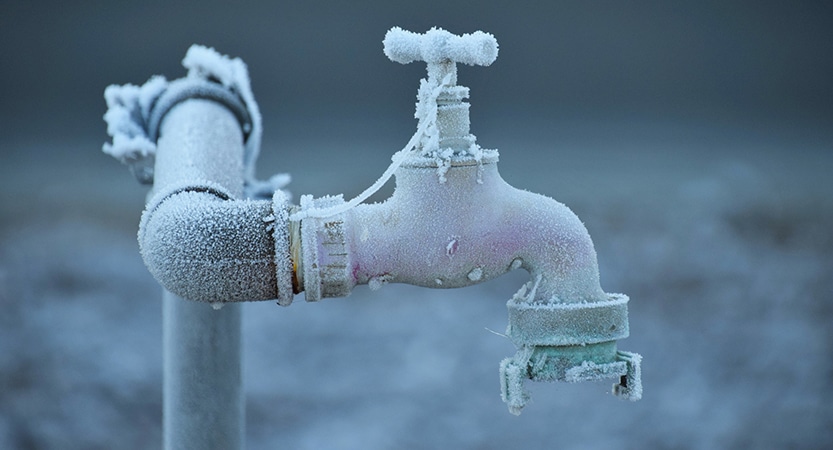Tips to Avoid Frozen Pipes in Winter: Pro Advice
Tips to Avoid Frozen Pipes in Winter: Pro Advice
Blog Article
The writer is making a number of great pointers on the subject of How To Avoid Freezing Pipes in general in the content down below.

Cold weather can damage your pipes, specifically by freezing pipes. Below's just how to prevent it from occurring and what to do if it does.
Intro
As temperatures decrease, the danger of icy pipelines boosts, potentially bring about pricey repair work and water damage. Understanding just how to stop frozen pipes is critical for house owners in chilly environments.
Comprehending Frozen Pipes
What triggers pipelines to freeze?
Pipes ice up when exposed to temperatures below 32 ° F (0 ° C) for expanded durations. As water inside the pipes ices up, it expands, putting pressure on the pipe wall surfaces and possibly causing them to burst.
Threats and problems
Frozen pipelines can cause water supply disturbances, residential property damages, and costly fixings. Burst pipelines can flooding homes and create considerable structural damage.
Signs of Frozen Water Lines
Determining frozen pipes early can avoid them from bursting.
Exactly how to recognize icy pipes
Look for lowered water flow from faucets, uncommon smells or sounds from pipes, and noticeable frost on exposed pipes.
Avoidance Tips
Protecting susceptible pipelines
Wrap pipes in insulation sleeves or utilize heat tape to secure them from freezing temperature levels. Concentrate on pipelines in unheated or outside locations of the home.
Home heating methods
Keep indoor rooms effectively heated up, particularly areas with plumbing. Open cupboard doors to enable cozy air to circulate around pipelines under sinks.
Shielding Outside Pipes
Garden hose pipes and exterior faucets
Detach and drain pipes garden hose pipes prior to winter season. Install frost-proof spigots or cover outside taps with protected caps.
What to Do If Your Pipelines Freeze
Immediate actions to take
If you think frozen pipes, keep faucets open up to soothe pressure as the ice thaws. Make use of a hairdryer or towels taken in warm water to thaw pipelines gradually.
Long-Term Solutions
Architectural adjustments
Consider rerouting pipelines away from outside wall surfaces or unheated locations. Add added insulation to attics, basements, and crawl spaces.
Updating insulation
Purchase premium insulation for pipes, attics, and wall surfaces. Correct insulation helps keep regular temperatures and lowers the risk of icy pipes.
Verdict
Avoiding icy pipelines requires positive actions and quick reactions. By recognizing the reasons, signs, and preventive measures, homeowners can safeguard their pipes during cold weather.
5 Ways to Prevent Frozen Pipes
Drain Outdoor Faucets and Disconnect Hoses
First, close the shut-off valve that controls the flow of water in the pipe to your outdoor faucet. Then, head outside to disconnect and drain your hose and open the outdoor faucet to allow the water to completely drain out of the line. Turn off the faucet when done. Finally, head back to the shut-off valve and drain the remaining water inside the pipe into a bucket or container. Additionally, if you have a home irrigation system, you should consider hiring an expert to clear the system of water each year.
Insulate Pipes
One of the best and most cost-effective methods for preventing frozen water pipes is to wrap your pipes with insulation. This is especially important for areas in your home that aren’t exposed to heat, such as an attic. We suggest using foam sleeves, which can typically be found at your local hardware store.
Keep Heat Running at 65
Your pipes are located inside your walls, and the temperature there is much colder than the rest of the house. To prevent your pipes from freezing, The Insurance Information Institute suggests that you keep your home heated to at least 65 degrees, even when traveling. You may want to invest in smart devices that can keep an eye on the temperature in your home while you’re away.
Leave Water Dripping
Moving water — even a small trickle — can prevent ice from forming inside your pipes. When freezing temps are imminent, start a drip of water from all faucets that serve exposed pipes. Leaving a few faucets running will also help relieve pressure inside the pipes and help prevent a rupture if the water inside freezes.
Open Cupboard Doors
Warm your kitchen and bathroom pipes by opening cupboards and vanities. You should also leave your interior doors ajar to help warm air circulate evenly throughout your home.

We were shown that editorial on How to Prevent Your Pipes From Freezing through an acquaintance on a different web address. Are you aware of another person who is truly interested in How to Prevent Your Pipes From Freezing? Please feel free to share it. Thanks a bunch for being here. Return soon.
Book Services Report this page